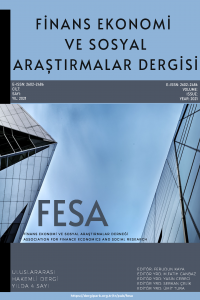DÖVİZ KURU DALGALANMALARI VE ÖDEMELER DENGESİ: TÜRKİYE'DEN KANITLAR
Döviz Kuru Değişimi, Ödemeler Dengesi, ARDL, Birim Kök, Eş Bütünleşme, TCMB, Sınır Testi, ADF, Phillips Perron Testi
EXCHANGE RATE FLUCTUATIONS AND THE BALANCE OF PAYMENTS: EVIDENCE FROM TÜRKİYE
Exchange Rate Fluctuations, The Balance of Payment, ARDL, Unit Root, Cointegration, CBRT, Bound Test, ADF, Phillips Perron Test,
___
- Afolabi, B., and Sherif, A. (2017). The Analysis of Exchange Rate Fluctuation on Nigeria’s Balance of Payments. International Research Journal of Finance and Economics, issue (163)
- Ahmad, N., Ahmed, R., Khoso, I., Palwishah, R., & Raza, U. (2014). Impact of exchange rate on balance of payment: An investigation from Pakistan. Research Journal of Finance and Accounting, 5(13), 2222-1697.
- Alawattage, U. P. (2009). Exchange rate, competitiveness and balance of payment performance. Staff Studies, 35(1).
- Dickey, D. A., & Fuller, W. A. (1979). Distribution of the estimators for autoregressive time series with a unit root. Journal of the American statistical association, 74(366a), 427-431.
- Frenkel, J. A., & Johnson, H. G. (1976). The monetary approach to the balance of payments: essential concepts and historical origins. The monetary approach to the balance of payments, 21-45.
- Gebremariam, T. K., Batu, M. M., & Tola, S. (2018). The effect of real effective exchange rate on balance of payments in Ethiopia: A co-integrated VAR approach. Journal of Economics and International Finance, 10(12), 156-165.
- Iyoboyi, M., & Muftau, O. (2014). Impact of exchange rate depreciation on the balance of payments: Empirical evidence from Nigeria. Cogent Economics & Finance, 2(1), 923323.
- Kandil, M. (2004). Exchange rate fluctuations and economic activity in developing countries: Theory and evidence. Journal of Economic Development, 29, 85-108.
- Lerner, A.P. (1944). Economics of Control: Principles of Welfare Economics‟. The Macmillian Company. N.Y.
- Levacic, R., and Rebmann, A. (1982). Macroeconomics; London, Macmillian Publishers Ltd, Pp. 89-100.
- Marshall, A. (1923). Money, credit and commerce‟, London, Macmillan.
- Odili, O. (2014). Exchange rate and balance of payment: An autoregressive distributed Lag (ARDL) econometric investigation on Nigeria. IOSR Journal of Economics and Finance, 4(6), 21-30.
- Pilbeam, K. (1998). International Finance, 2nd Edition. Palgrave Macmillan Texts in Economics, Macmillan, London.
- Salasevicius, R. and Vaicius, P. (2003). Exchange Rate Relationship: Testing the Marshall-Lerner Condition in the Baltic States. Stockholm School of Economics in Riga. SSE Riga Working Papers 2003: 13(48).
- Whitman, Marina V. N. (1975). The Payments Adjustment Process and the Exchange Rate Regime: What Have We Learned? The American Economic Review, 65(2), 133-146.
- Yayın Aralığı: Yılda 4 Sayı
- Başlangıç: 2016
- Yayıncı: Ferudun KAYA
AR-GE GİDERLERİ ÜZERİNDE YÖNETİM KURULU YAPISININ ETKİSİ: BIST UYGULAMASI
ÜNİVERSİTE ÖĞRENCİLERİNİN INSTAGRAM’A YÖNELİK ALGILARININ METAFOR ANALİZİ İLE İNCELENMESİ
COVID-19’UN SÜRÜ DAVRANIŞI ÜZERİNDEKİ ETKİSİ: GELİŞMEKTE OLAN AFRİKA ÜLKELERİ ÖRNEĞİ
KONAKLAMA İŞLETMELERİNİN FİNANSAL PERFORMANSLARININ SECA YÖNTEMİ İLE DEĞERLENDİRİLMESİ
MUHASEBEDE YAPAY ZEKA KULLANIMININ MESLEK ETİĞİNE ETKİLERİ: ChatGPT UYGULAMASI
ŞEFFAFLIK RAPORLARI PERSPEKTİFİNDEN BAĞIMSIZ DENETİM KALİTESİ
SEÇİLMİŞ MAKROEKONOMİK DEĞİŞKENLERİN TÜRKİYE’DEKİ KONUT FİYAT ENDEKSİ ÜZERİNDEKİ ETKİSİ
Tülay YAZAR ÖZTÜRK, Melike AKÇA
BANKA MÜŞTERİLERİNİN SERGİLEDİKLERİ DAVRANIŞSAL EĞİLİMLERİN BULANIK AHP YÖNTEMİ İLE ANALİZİ
PETROL FİYATI ŞOKU VE TÜRKİYE EKONOMİSİNİN MAKROEKONOMİK PERFORMANSI
